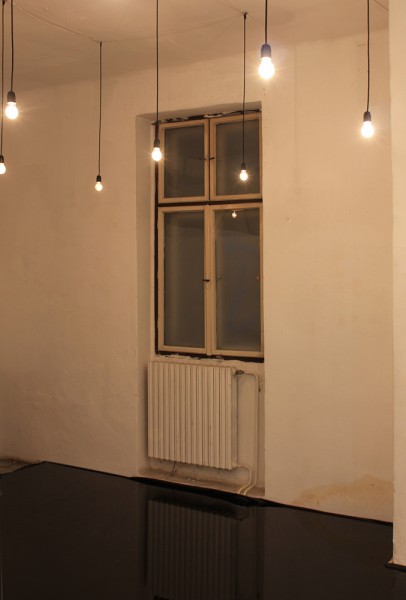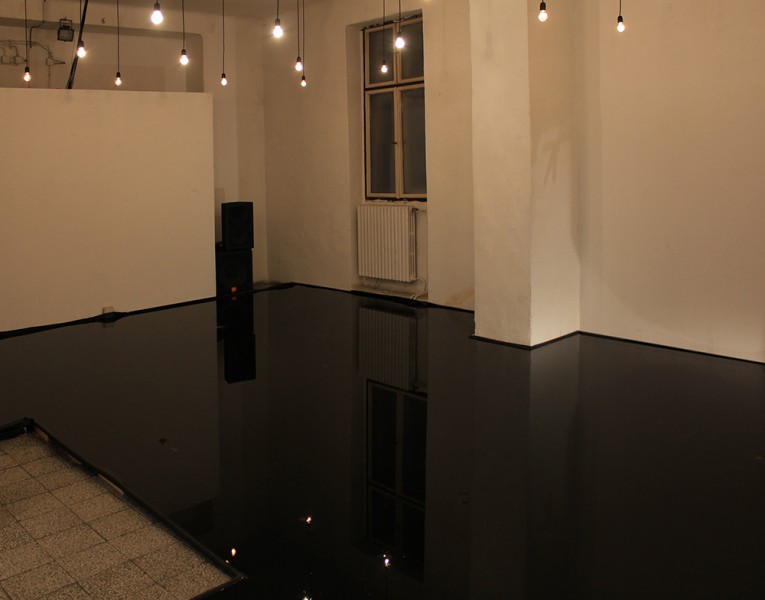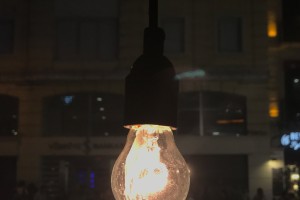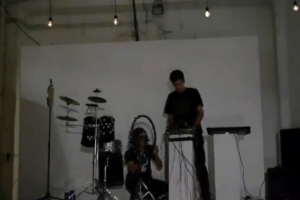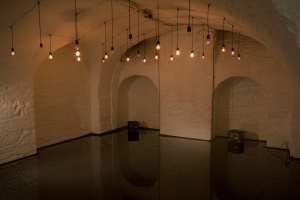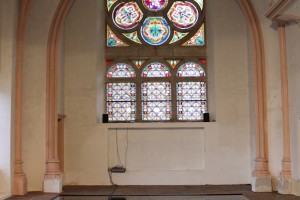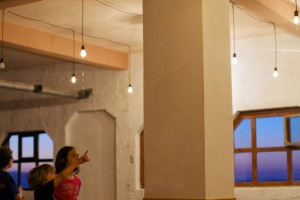The title of the project Clepsichor (clepsydra + choir) integrates two words – the Greek word clepsydra, which means a water clock that measures time by means of a regulated flow of liquid, and the English word choir.
However, the title does not refer only to its material manifestations, comprising 24 light bulbs of dynamic and varying power, from which water drips onto the flooded floor of the Gallery Magacin, as well as microphones registering the sounds produced by those drops. The choral aspect of this constellation presupposes a mutually interconnected relationship of the context, the installation and the audience. While LED light bulbs dominate when it comes to light installations (e.g. Jim Campbell, Scattered Light, New York 2010), Lazović’s installation was created, relating to the space of the Gallery Magacin as a context showing visible signs of deterioration, using ordinary, recognisable light bulbs. Lazović programmed the sounds created by drops of water falling from the light bulbs and synchronised the intervals of every drop, as well as their changes over time. Through variable dynamics, interaction of sounds and reflections of shadows on the walls of the Gallery Magacin, the artist tried to create suspense and to introduce changes in the internal human clock that isolated the audience from the external flow of time.
Entering this space, a visitor gets integrated as an important element of the installation. The role of the audience, which Lazović counts upon in the creative process, may be determined on the basis of the “art quotient”, which was defined by Marcel Duchamp as a subjective mechanism that produces a work of art. The visitors should be referred to as audience in this context, because this term denotes a much larger community than the public.
As opposed to the public, an audience has no transformative potential or agents to achieve a transformation in critical terms ( Rosler), which is not a shortcoming in this case, for this project does not aim for critical engagement. The audience referred to here presupposes plural, hybrid identities, understandings, practices and relations, and is dependent on the context, but is insufficiently defined (Livingstone 2005). The difference between the public and audience is not merely numerical, but is immanent to the quality of the relations among the agents involved. The public is characterised by precise mediation, whereas an audience is diffuse, which contributes to the unpredictability of the way in which this artistic installation will be rounded off, that is, of the way in which it will be received by those who will participate in it.
The interconnected relationship of the installation, the context and the audience comes into being as Lazović’s intervention presupposes a simultaneous material and psychological perceptual change of the spatial-temporal framework. Hence this artistic layout makes possible a shift away from the chronological, that is, measurable time, towards a temporal, that is, psychological and individual experience of time. The installation that estranges space through material (audio-visual) interventions also produces an estrangement of the neutral dimension of time and its measurable chronology by means of pointing to a subjective, socially constituted time and unpredictable cycles occurring as an effect of a psychic experience of that time.
The change upon which Lazović capitalises his work of art in this artistic installation occurs on several levels: relating to the ambience, the intensity of the sound, then as a shift from objective chronology to individual and differing temporalities, and as a shift from critical participation to individual and psychological perception.
Text by Maja Ćirić
